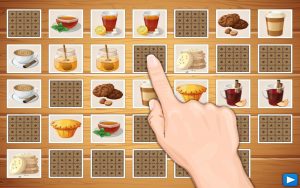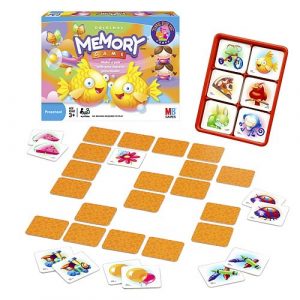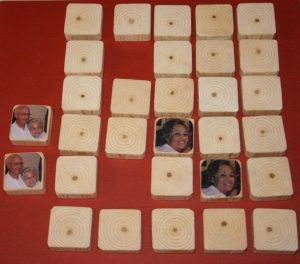
Match pairs is a card game in which all of the cards are laid face down on a surface and two cards are flipped face up over each turn. The object of the game is to turn over pairs of matching cards.
Basic information
Definition:
Match pairs (also known as Concentration, Match Match, Memory, Pelmanism, Shinkei-suijaku, Pexeso or simply Pairs) is a card game in which all of the cards are laid face down on a surface and two cards are flipped face up over each turn. The object of the game is to turn over pairs of matching cards.
The traditional game uses physical cards. Nevertheless, it also can be played online for free or as a mobile app.


Objectives
The object of the game is to turn over pairs of matching cards until all the available cards are faced up.
This game can be very good to improve the following cognitive dimensions:
Duration
Duration depends on the number of cards and the difficulty. One session will be normally quite short (1 to 5 minutes). This can be enlarged adding additional rules or incentives.
Cost:
- ICT version: free in many websites
- Physical version: from 10€
References:
- Explanation: https://en.wikipedia.org/wiki/Concentration_(game)
- Background material: download this pdf: EXAMPLE PDF TO DOWNLOAD.pdf
- Play online:
Development
Participants
Participants’ profile:
- Dementia level: game can be adjusted to match mild to moderate dementia levels.
- Physical requirements:
- Not high in general. For highly limited users, the game can be played using an assistant that follows the user’s instructions.
- For physical card games: good functionality at arms and hands (it will be more or less exigent depending on the card’s shape)
- For computer games: the ability to use a mouse
- For mobile/tablet games: basic functionality of arms and fingers. Consider the size of the device (higher requirements if played on a mobile phone than on a tablet).
Number of participants:
- This game can be played with any number of players or as solitaire.
Material and requirements
Materials needed to develop the game:
- In general:
- A table or other similar horizontal surface
- A chair would also be needed
- Physical game: the cards
- ICT game: a computer, tablet or mobile device.
Environment considerations:
- Good lighting levels. Avoid glare.
Support needed
Professionals / relatives can:
- Explain the game instructions and their variants
- Supervise the correct development of the game.
- Help with the counting / score
For ICT games, they can also help to use the ICT device.
In some cases (for highly physically limited users), they can turn the cards following the user’s instructions.
Starting point:
- Physical game: prepare the cards, faced down, on a table or horizontal surface.
- ICT game: select the difficulty level / variant and open the initial scree where all the cards are faced down.
Development:
(Important: these are general instructions for a pair game. The game admits several variations and alternatives)
Any deck of playing cards may be used, although there are also commercial sets of cards with images. The rules given here are for a standard deck of 52 cards, which are normally laid face down in four rows of 13 cards each. The two jokers may be included for a total of six rows of nine cards each.
Additional packs can be used for added interest. Standard rules need not be followed: the cards can be spread out anywhere, such as all around the room on a freshly-vacuumed carpet, again for added interest.
In turn, each player chooses two cards and turns them face up. If they are of the same rank and color (e.g. six of hearts and six of diamonds, queen of clubs and queen of spades, or both jokers, if used) then that player wins the pair and plays again. If they are not of the same rank and color, they are turned face down again and play passes to the player on the left. Rules can be changed here too: it can be agreed before the game starts that matching pairs be any two cards of the same rank, a color-match being unnecessary, or that the match must be both rank and card suit.
The game ends when the last pair has been picked up. The winner is the person with the most pairs. There may be a tie for first place.
The game may be played solo either as a leisurely exercise, or with the following scoring method: play as normal, but keep track of the number of non-matching pairs turned over (this may be done using poker chips, pennies or by making marks on a sheet of paper). The object is to clear the tableau in the fewest number of turns, or to get the lowest possible score.
See an example of an ICT version of this game at the following video:
Additional information
Variants of the game:
- The game admits to be played alone, in pairs or in-group.
- Some online alternatives allow putting your own images (or you can make photos and create your own physical cards). This can be very interesting for Alzheimer users in order to create significant remembrance.
- Additional rules can be added, or even playing this game in combination with another. For example:
- Any Color: the matching pairs need only be of the same rank, not the same color. When playing with jokers, these count double because they are more difficult to match.
- One Flip: Players who make a successful pair win these cards but do not go again until their next turn.
- Fancy: The cards need not be laid out in a strict rectangular grid and many players have their own special layouts that include circular, triangular, or diamond-shaped formations. Dealers may select any layout they wish.
Alternative games:
Similar AD-GAMING games:
Other related games:
Image snap: Similar to match pairs and designed for dementia users:
- Visual memory games: http://eyecanlearn.com/perception/memory/
- Find the pairs: http://www.primarygames.com/puzzles/match_up/findthepair/
- SIMON Says
Assessment:
- Time needed to perform the game
- Number of mistakes
- Help needed
Notes / observations
- Searching on google you can find many possibilities to play this game for free. Search for: “memory game online”, “memo game online”, “match pairs online”
Practical activity
Some examples on how to prepare “memory” or “match pairs” games.
Physical cards:
Make the game using power point:
![]()


